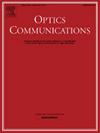利用飞秒激光矢量束在 4H-SiC 上制作凹槽
IF 2.2
3区 物理与天体物理
Q2 OPTICS
引用次数: 0
摘要
飞秒激光在各种材料上开槽和生成激光诱导周期性表面结构(LIPSS)的能力已得到广泛认可。LIPSS 结构包括 LSFL(低空间频率 LIPSS)和 HSFL(高空间频率 LIPSS)。在这项研究中,使用分段波板(SWP)将波长为 515 nm 的线性偏振飞秒激光高斯光束转化为具有甜甜圈形能量峰分布以及方位和径向偏振的矢量光束。在三种不同的碳化硅表面条件(抛光和预处理(LSFL 和 HSFL))下,使用线性、方位和径向偏振进行开槽。这项研究调查了微观结构形态的差异,并比较了沟槽的烧蚀深度。研究发现,与抛光表面相比,在预处理的 LSFL 4H-SiC 表面开槽产生的沟槽烧蚀深度更高。此外,在 HSFL 表面使用方位偏振可以在预处理期间形成的初始周期性结构(周期约为 250 nm)之间形成精细的 HSFL 结构(周期约为 100 nm)。本文章由计算机程序翻译,如有差异,请以英文原文为准。
Fabrication of grooves on 4H–SiC using femtosecond laser vector beam
Femtosecond lasers are widely acknowledged for their capability to groove and generate laser-induced periodic surface structures (LIPSS) on various materials. LIPSS structures include LSFL (low spatial frequency LIPSS) and HSFL (high spatial frequency LIPSS). In this study, a segmented waveplate (SWP) was used to transform a linearly polarized femtosecond laser Gaussian beam with a wavelength of 515 nm into a vector beam with a donut-shaped energy peak distribution and polarization of azimuthal and radial. Grooving was conducted on three different SiC surface conditions: polished and pre-processed (LSFL and HSFL), using linear, azimuthal, and radial polarization. This study investigated the differences in microstructure morphology and compared the ablation depths of the grooves. It was found that grooving on pre-processed LSFL 4H–SiC surfaces resulted in grooves with higher ablation depths than those produced on polished surfaces. Additionally, using azimuthal polarization on the HSFL surface could create fine HSFL structures (with a period of approximately 100 nm) between the initial periodic structures (with a period of approximately 250 nm) formed during the pre-processing.
求助全文
通过发布文献求助,成功后即可免费获取论文全文。
去求助
来源期刊

Optics Communications
物理-光学
CiteScore
5.10
自引率
8.30%
发文量
681
审稿时长
38 days
期刊介绍:
Optics Communications invites original and timely contributions containing new results in various fields of optics and photonics. The journal considers theoretical and experimental research in areas ranging from the fundamental properties of light to technological applications. Topics covered include classical and quantum optics, optical physics and light-matter interactions, lasers, imaging, guided-wave optics and optical information processing. Manuscripts should offer clear evidence of novelty and significance. Papers concentrating on mathematical and computational issues, with limited connection to optics, are not suitable for publication in the Journal. Similarly, small technical advances, or papers concerned only with engineering applications or issues of materials science fall outside the journal scope.
 求助内容:
求助内容: 应助结果提醒方式:
应助结果提醒方式:


